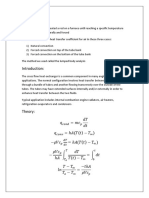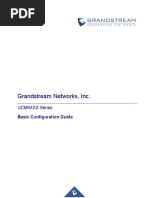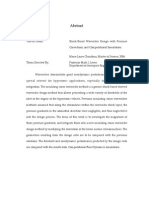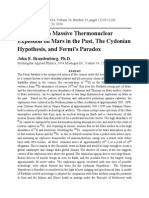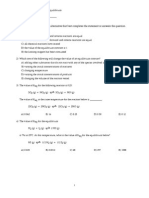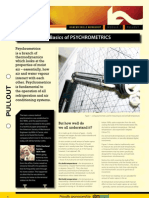Model Building and Simulation of Thermoelectric Module Using Matlab-Simulink
Uploaded by
megustalazorraModel Building and Simulation of Thermoelectric Module Using Matlab-Simulink
Uploaded by
megustalazorraJournal of ELECTRONIC MATERIALS, Vol. 39, No.
9, 2010
DOI: 10.1007/s11664-009-0994-x 2009 TMS
Model Building and Simulation of Thermoelectric Module Using Matlab/Simulink
HUAN-LIANG TSAI1,3 and JIUM-MING LIN2
1.Department of Electrical Engineering, Da-Yeh University, Chang-Hua, Taiwan, ROC. 2.Mechanical Engineering Department, Chung Hua University, Hsin-Chu, Taiwan, ROC. 3.e-mail: michael@mail.dyu.edu.tw
This paper presents implementations and verication of models of thermoelectric cooler and generator modules using Matlab/Simulink. The proposed models are designed with a user-friendly icon and a dialog box, like Simulink block libraries, making them easy to use for simulation, analysis, and optimization of further applications. Key words: Thermoelectric cooler, thermoelectric generator, thermoelectric module
INTRODUCTION Thermoelectricity was initially discovered in the early 1800s. A voltage is generated when a junction of two dissimilar materials is held at a different temperature. Thermoelectric materials began to be made with n-type and p-type structure in the middle of the 1900s due to the prevalence of semiconductor materials. Through control of the carrier concentration, optimization of the bandgap can be achieved for the thermoelectric couple. Many thermocouples are then interconnected electrically in series to increase the operating voltage and thermally in parallel to increase the thermal conductivity, forming a thermoelectric module (TEM). TEM devices can typically be classied into thermoelectric generators (TEGs) and thermoelectric coolers (TECs). TEGs convert thermal energy from a temperature gradient to electrical energy (Seebeck effect), whereas TECs convert electrical energy into a temperature gradient (Peltier effect). Being basically solid-state energy converters with no mechanical and moving parts, TEM devices can provide the benets of noiselessness, compactness, reliability, and stability. However, having poor energy conversion efciency, both TECs and TEGs were largely considered for niche applications due to their unique advantages. In general, TECs are
(Received June 4, 2009; accepted October 28, 2009; published online November 19, 2009)
capable of cooling and refrigeration, such as in specialized coolers for optoelectronic and electronic components and portable electric food coolers/heaters. They are especially useful for precise temperature control applications where accuracy, simplicity, reliability, and compactness are dominant concerns. On the other hand, TEGs can be used to harness waste heat with available temperature difference and produce electric power, such as for power generation in spacecraft systems and as thermocouples for temperature measurement. With the rising costs of fossil fuels and the innovative technologies of waste-heat recovery, TEG devices are becoming more prominent, especially in applications and markets for broader automobile systems and remote self-powered sensor and wireless communication systems. Mathematical models of TEM for both TECs and TEGs have been well developed to simulate their corresponding behaviors and analyze their performance.1,2 Modeling and simulation allows for analysis, design, and optimization of TEMs to cut down the design cycle. Recently, equivalent circuit models of TEMs have been built using SPICE software for easy module analysis and for further extraction of model parameters from specications in commercial datasheets.37 Basically, equivalent-circuit models implemented using SPICE are suitable for simulation of power-electronics applications. For the control objective, it is better to build a TEM model using the Matlab/Simulink package and further to use its SimPowerSystem tool, especially for the
2105
2106
Tsai and Lin
development of temperature control and maximum power point tracking (MPPT) technologies for TEC and TEG applications. PRINCIPLE OF THERMOELECTRIC MODULE The construction of both TECs and TEGs is basically the same, and consequently the same equivalent circuit can be used to simulate their behavior. The basic unit of a TEM is a thermocouple that consists of a p-type and n-type pellet couple interconnected by metal. A TEM has the form of thermopiles that are connected electrically in series to increase the operating voltage and thermally in parallel to decrease the thermal resistance, and is sandwiched between two ceramic plates for uniform thermal expansion. There are four main energy processes taking place in the TEM pellets: thermal conduction, Joule heating, the Peltier cooling/heating effect, and the Seebeck effect. The additional Thompson effect, which is described by the Thompson coefcient s dS=dT ; is small enough to be neglected. Both ceramic plates and interconnected metals have high thermal conductivity to ensure uniform temperature at either end. Neglecting the contribution of the metal interconnectors and ceramic plates, the analysis of a TEM can be conducted by analyzing a single pellet or thermocouple without loss of generality. The phenomenon of thermal conduction is a Fourier process that is described by the thermal conductivity ji of the material. For a TEM with N thermocouples, the heat transfer of thermal conduction in a TEM is described by Qth DT jth ; (1)
cool sides of the conductor is called the Seebeck effect. The generated Seebeck voltage, called the electromotive force (EMF), in a TEM is expressed as US SDT : (4)
Applying the concept of energy equilibrium for steady-state analysis at both sides of the TEM, the absorbed heat generated by the thermal load, QA, and the liberated heat removed by the heat sink, QE, are, respectively, given by QA SITA 0:5I 2 R jth DT and QE SITE 0:5I 2 R jth DT : The TEMs output voltage is then V US IR: (7) (6) (5)
A good TEM must combine a large Seebeck coefcient S with low electrical resistance R and low thermal conductivity jth . The gure-of-merit (FOM) parameter is then dened as Z S2 =Rjth : (8)
DETERMINATION OF TEM PARAMETERS In general, TEC manufacturers provide the following parameters to specify their products: DTmax, the maximal temperature difference between the cold and hot sides of the TEC; Imax and Vmax, the current and voltage inputs to produce DTmax for a given level of TH. The hot-side temperature of a working TEC is always constant and is nearly equal to the temperature of the material used in the cooling system. In addition, it is easier to measure the hot-side temperature because this surface is always outside of the TEC device. For cooling, one can assume that TE = TH and TA TH DT , and QA is set to zero for thermal insolation. The temperature difference can be expressed as DT SITH 0:5I 2 R=SI jth : (9)
where jth is the thermal conductivity of the TEM and DT TE TA : Joule heating is a physical process of heat dissipation in a resistance element. The ow of electric current through the TEM will additionally cause resistive heating of the thermocouples. The total Joule heat dissipated in an N-couple TEM is Q J I 2 R; (2)
where R is its electrical resistance. Irrespective of the temperature gradient, the Joule heat can be considered as equally divided between the two sides of the TEM. The Peltier cooling/heat effect is a phenomenon of heat absorption/dissipation by a junction between two dissimilar materials when electrical current ows through the junction. The absorbed/emitted heat of an N-couple TEM is QPE=PA SITE=A ; (3)
The maximal temperature difference can be found by taking the derivative of DT with respect to I and setting the result to zero. The maximal current and temperature can be derived as Imax jth 1 2ZTH 0:5 1=S and DTmax TH 1 1 2ZTH 0:5 =Z: Then, the maximal voltage can be rewritten as Vmax STH : (12) (11) (10)
where S is the TEMs Seebeck coefcient. When a temperature gradient is imposed on a conductor under an open-circuit condition, the creation of an electrical potential difference between the hot and
Model Building and Simulation of Thermoelectric Module Using Matlab/Simulink
2107
(a)
Hot_Side_Temperature Hot-side Temperature Cold_Side_Temperature Cold-side Temperature TEC Module Voltage Scope
DC Power supply
Current Scope
(b)
f(u) Seeback Coefficient Function f(u) Resistance Function f(u) Thermal Conductivity Function f(u) 1 Hot-side Temperature 2 Cold-side Temperature f(u) Voltage Function 2 Voltage Scope Current Function 1 Current Scope f(u) FOM Function
5.1333e-002 Seeback coefficient 2.5268e-003 FOM 1.1909e+000 Resistance 8.7569e-001 Thermal Conductivity
(c)
Fig. 1. TEC module: (a) masked implementation, (b) subsystem implementation, and (c) dialog box.
2108
Tsai and Lin
max mopt DT gmax th TC =DT gth TH ;
Therefore, given the emitting temperature TE = TH, the parameters of the proposed model can be calculated by S Vmax =TH ; (13)
(23)
and then the FOM of the TEG can be found as Z m 2 opt 1=Tave : (24)
R Vmax 1 DTmax =TH =Imax ; and Rth Vmax Imax TH DTmax =2TH DTmax :
(14)
The thermal conductivity of a TEG can be calculated by jth S2 =RZ: (25)
(15)
On the other hand, the regular parameters in the datasheet of commercial TEGs include: TA = TH and TE = TC, the hot-side and cold-side temperatures; Wm, the power at the load matched to the internal resistance (RL = R); Vm (=VR), the load voltage at the matched load; and gmax th ; the maximum thermal efciency. Obviously, one can easily calculate the electrical parameters of the equivalent circuit directly from the datasheet. The electrical resistance R and the Seebeck coefcient S of a TEG can be expressed as
2 = Wm ; R RL V m
Some manufacturers give the efciency for the matched load gth,m. Since the matched load resistance is matched to the internal resistance, i.e., RL = R, the current at the matched load is found to be Im SDT =2R; (26)
and the efciency at the matched load is expressed as gth;m ZDT =4 Z1:5TH 0:5TC : The FOM of the TEG is then calculated by
m Z 4 gm TEG =DT gTEG 1:5TH 0:5TC :
(27)
(16)
(28)
and S 2Vm =DT : (17)
Finally, the thermal resistance can be obtained. MODEL BUILDING AND SIMULATION Given the fundamental specications of a TEC directly from the manufacturers datasheets, the parameters of the proposed model can be calculated by Eqs. 1820. For a cooling application, the coldside temperature of the TEC, TC, is a desired input and then the temperature difference can be obtained for a given hot-side temperature TH, i.e., DT TH TC . This temperature difference can be
In fact, the efciency of a TEG is a function of the load. Assume that the load resistance is dened as RL = mR, where m is the resistance ratio between the load and internal resistance. The current can be expressed as I SDT =1 mR: (18)
The thermal efciency of a TEG is dened as the ratio of the electric power output to the thermal power input to the hot side, which can be expressed as gth I 2 RL =QH : (19)
16 14 12 10 : Current (A) : Voltage (V) 16 14 12 10 8 6 4 2 0 300
Given the FOM, the TEGs thermal efciency can be reformulated as gth mZDT =f1 m2 Zm 0:5TH 0:5TC g: (20)
Current (A)
Obviously, the TEGs efciency is a function of the resistance ratio m. The maximal efciency can be given as gmax th mopt 1DT =TH =mopt TC =TH ; (21)
8 6 4 2
where mopt is the value of resistance ratio m that maximizes the efciency of the TEG, which is mopt 1 ZTave 0:5 ; (22)
where Tave 0:5TH TC . Given the parameters of a commercial TEG, the resistance ratio m can be obtained as
230
240
250
260 270 280 Temperature (K)
290
Fig. 2. TCI and TCV output characteristics.
Voltage (V)
Model Building and Simulation of Thermoelectric Module Using Matlab/Simulink
2109
(a)
Hot_Side_Temperature
QH
Hot-side Temperature
QC
Current Scope
Cold_Side_Temperature Cold-side Temperature
DC-DC Converter
TEG Module
Voltage Scope
(b)
f(u) Seeback Coefficient Function -CResistance Function f(u) Voltage Function 2 Voltage Scope f(u) Current Function 1 Current Scope
2.3800e-002 Seebeck Coefficient
2.9813e-001 Resistance
Hot-side Temperature 1 2 Cold-side Temperature
f(u) Optimal Load Resistance Function
f(u) FOM Function
f(u) Thermal Conductivity Function
1.6985e+000 Thermal Conductivity 1.1186e-003 FOM
(c)
Fig. 3. TEG module: (a) masked implementation, (b) subsystem implementation, and (c) dialog box.
2110
Tsai and Lin
5 4.5 4
Voltage (V) / Efficiency (%)
used to calculate the required current input, which can be expressed as I fSTH DT STH DT 2DT =Z The voltage of the TEC is then given as V Vmax STH DT 2DT =Z
2 0: 5 2 0:5
20 18 16 14
Power (W)
g=R: (29)
3.5 3 2.5 2 1.5 1 0.5 0 0 2 : Voltage (V) : Power (W) : Efficiency (%) 4 6 8 10 Current (A) 12 14
12 10 8 6 4 2 0 16
(30)
Therefore, the proposed model and its subsystem for the TEC module can be implemented using Matlab/ Simulink as shown in Fig. 1ac. In order to make the proposed model easier to use and understand, the user-friendly icon with an image le of a TEC icon is shown in Fig. 1b. In addition, the masked model is designed to have a dialog box as shown in Fig. 1c, in which the parameters of the TEC module can be congured in the same way as for Simulink block libraries. Taking the TEC1-12710 cooling module as an example, the manufacturers datasheets show that DS = 68C, Imax = 10 A, and Vmax = 15.4 V under the condition that TH = 27C. Through the conguration dialog of TEC block, the model parameters are S 0:0513 V/K ; R 1:1909 X; jth 0:8757 W/K, and Z 0:0026 K 1 ; as shown in Fig. 1b. The output characteristics of TCI and TCV for the TEC are shown in Fig. 2. In order to control the cold-side temperature to the value of 270 K, the output current and power supply voltage are set to 2.1 A and 4.1 V, respectively. From the standpoint of TEG applications, it is highly desirable to maximize power output, which is the load power at the matched load of RL = R. The maximum current is the short-circuit current at VL = 0, i.e., ISC 2Im 2Wm =Vm : (31)
Fig. 4. IV and IW output characteristics.
Therefore, the voltage output can be formulated as V RI ISC : (32)
Taking an HZ-20 module for example, the manufacturers datasheets show that TH = 230C, TC = 30C, Wm = 19 W, Vm = 2.38 W, and gmax = 4.5%. Through the conguration dialog of TEG block, one can calculate the model parameters: S 0:0238 V/K ; R 0:2981 X; jth 1:6985 W/K, and Z 0:0011 K1 ; as shown in Fig. 2b. The output characteristics of IV and IW for the TEG are shown in Fig. 4. The TEG has maximum power output with the matched load of RL = R. Taking the hot-side temperature as an input variable, the output characteristics of current, voltage, and power at the matched load are depicted in Fig. 3ac. These results reveal that the maximum power is about 19 W at I = 7.9832 A and V = 2.3800 V, and the maximal thermal efciency is 4.5% as I approaches about 7.2 A. For the MPPT design of the TEG, the working voltage of the DCDC converter is controlled at 2.38 V. CONCLUSIONS The utility of both TEC and TEG modules is based on the commercial datasheets of TEM manufacturers. TEM parameters can be extracted and performance analysis conducted in this way. The TEC and TEG models proposed herein are compatible with Matlab/Simulink libraries for further DC and AC electronic circuit simulation. These models are built in the same way as Simulink block libraries. The masked icon makes the block model more userfriendly, and a dialog box allows the user to congure the TEM model easily. Such user-friendly blocks are easy to use for applications of temperature control systems and maximum power point trackers. On the other hand, validation experiments of the proposed TEC and TEG models are still lacking; they will be carried out at the Clean Energy Research Center (CERC) of Da-Yeh University.
The hot-side temperature TH is a source input and the temperature difference can be obtained for a given cold-side temperature TC as DT TH TC . Then, the current output and voltage of the TEG can be calculated from Eqs. 29 and 32 with the temperature of the heat source remaining constant. The output power and thermal efciency can be represented as functions of the electric current. The proposed model and its subsystem for TEG module are implemented using Matlab/Simulink as shown in Fig. 3ac. In order to make the proposed model easier to use and understand, an image le of the TEG icon is used as a masking icon. The userfriendly icon is shown in Fig. 3a. In addition, the masked model is designed to have a dialog box as shown in Fig. 3c, in which the parameters of the TEG module can be congured in the same way as for Simulink block libraries.
Model Building and Simulation of Thermoelectric Module Using Matlab/Simulink
2111
REFERENCES
1. A.F. Ioffe, Semiconductor Thermoelements and Thermoelectric Cooling (London, UK: Infoserch Limited, 1957). 2. S.W. Angrist, Direct Energy Conversion (Boston: Allyn and Bacon, 1982), p. 177. vez, J.A. Ortega, J. Salazar, A. Turo , and M.J. Garc a, 3. J.A. Cha IEEE IMTC. P. 2, 1019 (2000). doi:10.1109/IMTC.2000.848895. 4. S. Lineykin and S. Ben-Yaakov, IEEE Power Electron. Lett. 3, 63 (2005). doi:10.1109/LPEL.2005.846822.
, J. Salazar, A. Turo , M.J. Garc a, and 5. D. Mitrani, J.A. Tome vez, IEEE Trans. Instrum. Meas. 54, 1548 (2005). J.A. Cha doi:10.1109/TIM.2005.851473. 6. M. Chen, L.A. Rosendahl, I. Bach, T. Condra, and J.K. Pedersen, Int. Conf. Thermoelect., 214 (2006). doi: 10.1109/ICT.2006.331335. 7. S. Lineykin and S. Ben-Yaakov, IEEE Trans. Ind. Appl. 43, 505 (2007). doi:10.1109/TIA.2006.889813.
You might also like
- IB Topic 3 Thermal Physics Question Booklet67% (3)IB Topic 3 Thermal Physics Question Booklet19 pages
- 16-Bit MCU & DSC Programmer's Reference Manual100% (1)16-Bit MCU & DSC Programmer's Reference Manual460 pages
- Chapter7. FET Biasing: JFET Biasing Configurations Fixed Biasing Self Biasing & Common Gate Voltage DividerNo ratings yetChapter7. FET Biasing: JFET Biasing Configurations Fixed Biasing Self Biasing & Common Gate Voltage Divider42 pages
- A Study of The Seebeck and Peltier Thermoelectric Effects80% (5)A Study of The Seebeck and Peltier Thermoelectric Effects59 pages
- Report 5 Inductance of A Bundled ConductorNo ratings yetReport 5 Inductance of A Bundled Conductor15 pages
- Circuit BrakerCutler Hammer 4160 Breaker 69C3076No ratings yetCircuit BrakerCutler Hammer 4160 Breaker 69C307672 pages
- Using LabVIEW and Lab Windows CVI With Teststand ManualNo ratings yetUsing LabVIEW and Lab Windows CVI With Teststand Manual129 pages
- Kongsberg Maritime - Process Simulation D-SPICE DCSNo ratings yetKongsberg Maritime - Process Simulation D-SPICE DCS2 pages
- NES 727 Guide To The Design and Manufacture of Awnings and Associated Screens and Covers Category 3No ratings yetNES 727 Guide To The Design and Manufacture of Awnings and Associated Screens and Covers Category 358 pages
- A LabVIEW Based Autonomous Airship Flight Controller100% (1)A LabVIEW Based Autonomous Airship Flight Controller112 pages
- Manual - LabVIEW 3 Hour Hands-On With MyDAQNo ratings yetManual - LabVIEW 3 Hour Hands-On With MyDAQ113 pages
- (Project) Modelling and Control of Autonomous Quadrotor100% (1)(Project) Modelling and Control of Autonomous Quadrotor149 pages
- Modeling and Analysis of Thermoelectric Modules: Simon Lineykin and Shmuel Ben-Yaakov, Member, IEEENo ratings yetModeling and Analysis of Thermoelectric Modules: Simon Lineykin and Shmuel Ben-Yaakov, Member, IEEE8 pages
- Equivalent Electrical Circuits of Thermoelectric Generators Under Different Operating ConditionsNo ratings yetEquivalent Electrical Circuits of Thermoelectric Generators Under Different Operating Conditions15 pages
- Experimental Study On Waste Heat Recovery From An Internal Combustion Engine Using Thermoelectric TechnologyNo ratings yetExperimental Study On Waste Heat Recovery From An Internal Combustion Engine Using Thermoelectric Technology13 pages
- Novel Approach To Thermoelectric Generator Modeling As Energy Harvesting System PDFNo ratings yetNovel Approach To Thermoelectric Generator Modeling As Energy Harvesting System PDF4 pages
- Thermal Modeling of Power Electronic SystemsNo ratings yetThermal Modeling of Power Electronic Systems20 pages
- 2016 Heat and Mass Transfer Practical ManualNo ratings yet2016 Heat and Mass Transfer Practical Manual8 pages
- Thermoelectric Power Generation Peltier Element Versus Thermoelectric GeneratorNo ratings yetThermoelectric Power Generation Peltier Element Versus Thermoelectric Generator6 pages
- Mass and Cost Model For Selecting Thruster Size in Electric Propulsion SystemsNo ratings yetMass and Cost Model For Selecting Thruster Size in Electric Propulsion Systems12 pages
- Shock-Based Waverider Design With Pressure Corrections, and Computational SimulationsNo ratings yetShock-Based Waverider Design With Pressure Corrections, and Computational Simulations106 pages
- Evidence of A Massive Thermonuclear Explosion On Mars in The Past, The Cydonian Hypothesis, and Fermi's ParadoxNo ratings yetEvidence of A Massive Thermonuclear Explosion On Mars in The Past, The Cydonian Hypothesis, and Fermi's Paradox51 pages
- HERMANN J. SCHAEFER, Ph.D. "Radiation Dosage in Flight Through The Van Allen Belt"No ratings yetHERMANN J. SCHAEFER, Ph.D. "Radiation Dosage in Flight Through The Van Allen Belt"9 pages
- Concepts For Near-Earth Asteroid Deflection Using Spacecraft With Advanced Nuclear and Solar Electric Propulsion SystemsNo ratings yetConcepts For Near-Earth Asteroid Deflection Using Spacecraft With Advanced Nuclear and Solar Electric Propulsion Systems13 pages
- T-SMAD: A Concurrent Design Tool For Space Mission Analysis and DesignNo ratings yetT-SMAD: A Concurrent Design Tool For Space Mission Analysis and Design6 pages
- Transient Chamber Pressure and Thrust in Solid Rocket MotorsNo ratings yetTransient Chamber Pressure and Thrust in Solid Rocket Motors37 pages
- Flight Path Optimization For An AirplaneNo ratings yetFlight Path Optimization For An Airplane120 pages
- Natural Ventilation and Collaborative DesignNo ratings yetNatural Ventilation and Collaborative Design5 pages
- Aspen Exchanger Design and Rating Shell & Tube V10: File: Printed: 01/07/2019 at 12:08:38 TEMA SheetNo ratings yetAspen Exchanger Design and Rating Shell & Tube V10: File: Printed: 01/07/2019 at 12:08:38 TEMA Sheet1 page
- Evaluation of HFO-1234YF As A Replacement For R134A in Frigori Fic Air Conditioning SystemsNo ratings yetEvaluation of HFO-1234YF As A Replacement For R134A in Frigori Fic Air Conditioning Systems7 pages
- Energy Efficient HVAC System With Spot Cooling in An Automobile - Design and CFD AnalysisNo ratings yetEnergy Efficient HVAC System With Spot Cooling in An Automobile - Design and CFD Analysis1 page
- Hot Water Supply and Distribution SystemNo ratings yetHot Water Supply and Distribution System26 pages
- Modine 23124 5H6041510003 T-STAT 40-90 Line Voltage StatNo ratings yetModine 23124 5H6041510003 T-STAT 40-90 Line Voltage Stat2 pages
- DISTRICT - Thirty Party Review Report-Sep, 2023No ratings yetDISTRICT - Thirty Party Review Report-Sep, 2023212 pages
- Experimental Investigation On Forced Convection Over A Rough Flat Plate and Related ImplicationsNo ratings yetExperimental Investigation On Forced Convection Over A Rough Flat Plate and Related Implications5 pages
- Study of Boiler Efficiency in Visakhapatnam Steel Plant50% (2)Study of Boiler Efficiency in Visakhapatnam Steel Plant39 pages
- Chapter7. FET Biasing: JFET Biasing Configurations Fixed Biasing Self Biasing & Common Gate Voltage DividerChapter7. FET Biasing: JFET Biasing Configurations Fixed Biasing Self Biasing & Common Gate Voltage Divider
- A Study of The Seebeck and Peltier Thermoelectric EffectsA Study of The Seebeck and Peltier Thermoelectric Effects
- Using LabVIEW and Lab Windows CVI With Teststand ManualUsing LabVIEW and Lab Windows CVI With Teststand Manual
- Kongsberg Maritime - Process Simulation D-SPICE DCSKongsberg Maritime - Process Simulation D-SPICE DCS
- NES 727 Guide To The Design and Manufacture of Awnings and Associated Screens and Covers Category 3NES 727 Guide To The Design and Manufacture of Awnings and Associated Screens and Covers Category 3
- A LabVIEW Based Autonomous Airship Flight ControllerA LabVIEW Based Autonomous Airship Flight Controller
- (Project) Modelling and Control of Autonomous Quadrotor(Project) Modelling and Control of Autonomous Quadrotor
- Modeling and Analysis of Thermoelectric Modules: Simon Lineykin and Shmuel Ben-Yaakov, Member, IEEEModeling and Analysis of Thermoelectric Modules: Simon Lineykin and Shmuel Ben-Yaakov, Member, IEEE
- Equivalent Electrical Circuits of Thermoelectric Generators Under Different Operating ConditionsEquivalent Electrical Circuits of Thermoelectric Generators Under Different Operating Conditions
- Experimental Study On Waste Heat Recovery From An Internal Combustion Engine Using Thermoelectric TechnologyExperimental Study On Waste Heat Recovery From An Internal Combustion Engine Using Thermoelectric Technology
- Novel Approach To Thermoelectric Generator Modeling As Energy Harvesting System PDFNovel Approach To Thermoelectric Generator Modeling As Energy Harvesting System PDF
- Thermoelectric Power Generation Peltier Element Versus Thermoelectric GeneratorThermoelectric Power Generation Peltier Element Versus Thermoelectric Generator
- Mass and Cost Model For Selecting Thruster Size in Electric Propulsion SystemsMass and Cost Model For Selecting Thruster Size in Electric Propulsion Systems
- Shock-Based Waverider Design With Pressure Corrections, and Computational SimulationsShock-Based Waverider Design With Pressure Corrections, and Computational Simulations
- Evidence of A Massive Thermonuclear Explosion On Mars in The Past, The Cydonian Hypothesis, and Fermi's ParadoxEvidence of A Massive Thermonuclear Explosion On Mars in The Past, The Cydonian Hypothesis, and Fermi's Paradox
- HERMANN J. SCHAEFER, Ph.D. "Radiation Dosage in Flight Through The Van Allen Belt"HERMANN J. SCHAEFER, Ph.D. "Radiation Dosage in Flight Through The Van Allen Belt"
- Concepts For Near-Earth Asteroid Deflection Using Spacecraft With Advanced Nuclear and Solar Electric Propulsion SystemsConcepts For Near-Earth Asteroid Deflection Using Spacecraft With Advanced Nuclear and Solar Electric Propulsion Systems
- T-SMAD: A Concurrent Design Tool For Space Mission Analysis and DesignT-SMAD: A Concurrent Design Tool For Space Mission Analysis and Design
- Transient Chamber Pressure and Thrust in Solid Rocket MotorsTransient Chamber Pressure and Thrust in Solid Rocket Motors
- Aspen Exchanger Design and Rating Shell & Tube V10: File: Printed: 01/07/2019 at 12:08:38 TEMA SheetAspen Exchanger Design and Rating Shell & Tube V10: File: Printed: 01/07/2019 at 12:08:38 TEMA Sheet
- Evaluation of HFO-1234YF As A Replacement For R134A in Frigori Fic Air Conditioning SystemsEvaluation of HFO-1234YF As A Replacement For R134A in Frigori Fic Air Conditioning Systems
- Energy Efficient HVAC System With Spot Cooling in An Automobile - Design and CFD AnalysisEnergy Efficient HVAC System With Spot Cooling in An Automobile - Design and CFD Analysis
- Modine 23124 5H6041510003 T-STAT 40-90 Line Voltage StatModine 23124 5H6041510003 T-STAT 40-90 Line Voltage Stat
- Experimental Investigation On Forced Convection Over A Rough Flat Plate and Related ImplicationsExperimental Investigation On Forced Convection Over A Rough Flat Plate and Related Implications
- Study of Boiler Efficiency in Visakhapatnam Steel PlantStudy of Boiler Efficiency in Visakhapatnam Steel Plant



